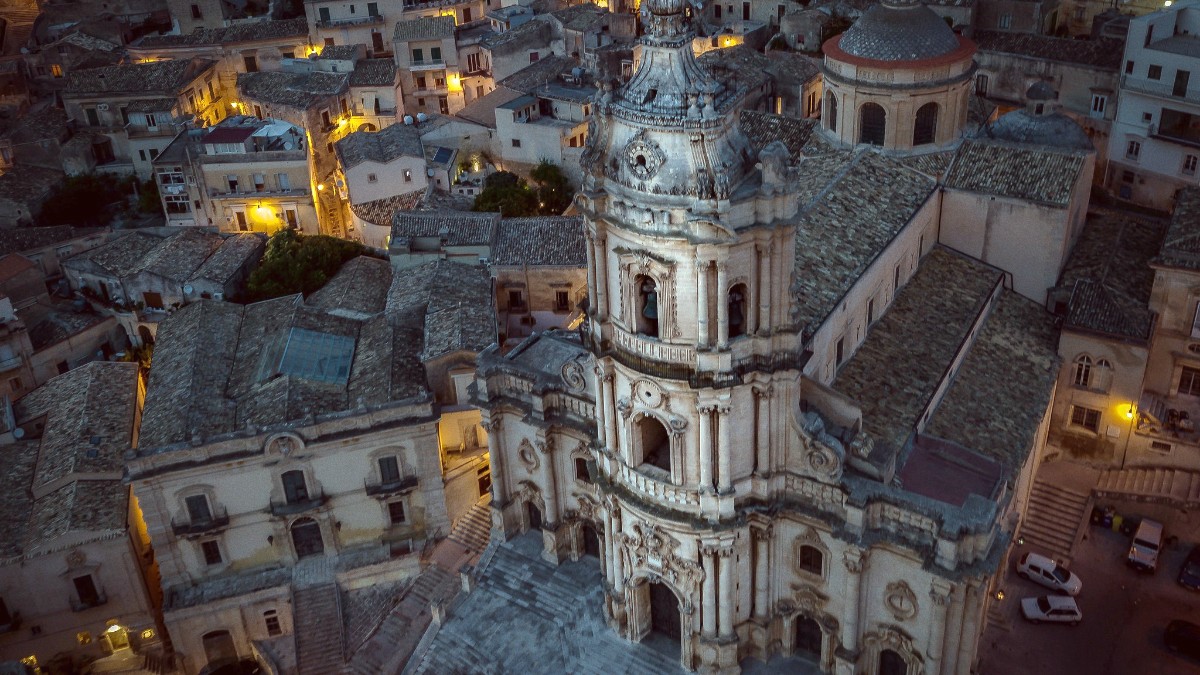
Sicily, Italy
The Duomo di San Giorgio is the masterpiece of Sicilian Baroque architecture and a symbol of Modica. Its grand, theatrical staircase (250 steps) leads to a towering, five-tiered facade. The church’s design creates a dynamic, undulating impression, making it one of Sicily’s most significant churches. It dominates the Modica Alta skyline.
The Duomo di San Pietro, an important Baroque church, stands prominently in Modica Bassa. Less dramatic than San Giorgio, San Pietro features a grand facade with Twelve Apostles statues lining the approach, creating a charming square. It anchors the lower city’s busy Corso Umberto I, a lively hub lined with shops, cafes, and restaurants.
The climb to the castle gives excellent photo opportunities of the city.
Approximately 10 km from Modica, Cava Ispica is a long, deep canyon of significant archaeological interest.
It features a necropolis, ancient cave dwellings, and settlements carved into the rock, dating back millennia.
It offers opportunities for hiking and exploring ancient history within a natural setting.
Reaching Cava Ispica does necessitate transport from Modica.
The canyon itself presents a beautiful natural environment alongside its historical sites.
Modica has several museums that give insight into its history, culture, and unique traditions.
Dedicated to the history and the unique cold-processing method of Modica chocolate. Exhibits cover the history of cacao, the tools used in traditional chocolate making, and its cultural significance. Often includes a tasting. Informative and gives context for Modica's famous product.
Located within the Castle of the Counts. This museum displays archaeological finds from the Modica area, artifacts related to the city's history, and ethnographic exhibits. It gives an understanding of Modica's ancient past and local life.
The birthplace of Salvatore Quasimodo, a Nobel Prize-winning poet (1959). This small museum is about his life and work, for insight into one of Italy's literary giants and his connection to Sicily.
Typically open 10:00 AM - 1:00 PM and 3:00 PM - 7:00 PM. Check for specific days open and seasonal variations.
Fees are usually minimal, for example, approximately €5-€7 for the Chocolate Museum. Check individual museum websites for current prices.
Combine a visit to the Chocolate Museum with a tasting at a traditional cioccolateria like Antica Dolceria Bonajuto for a full sensory experience.
Learn about the unique cold-processing method and the history of Modica's famous chocolate.
Explore archaeological finds and artifacts reflecting Modica's ancient past and local life.
A small museum dedicated to the life and works of the Nobel Prize-winning poet, connecting him to Sicily.
Modica is steeped in history, with sites that predate its Baroque splendor, offering historical layers.
While Modica itself is an urban center, its surroundings feature beautiful natural landscapes and coastal escapes.
A long, deep canyon with archaeological interest, featuring ancient cave dwellings and necropolis. Opportunities for hiking and exploring history in a natural setting.
Rolling limestone hills surrounding Modica, part of the Iblean mountain range. Scenic drives through dry stone walls, carob trees, and ancient olive groves.
Modica is close to several sandy beaches along the Mediterranean coast, perfect for a day trip to places like Marina di Modica or Sampieri.
Approximately 20 km from Modica, this is a popular and lively beach resort, with wide sandy beaches and facilities. It stands good for families.
View on MapAbout 25 km away, Sampieri is a picturesque fishing village known for its long sandy beach and the striking ruins of an old brick factory, Fornace Penna, standing dramatically on the coastline.
View on MapApproximately 30 km from Modica, this is a smaller, charming fishing village with pleasant beaches, less crowded than Marina di Modica.
View on MapA small fishing village and beach, famous for being the setting of the Inspector Montalbano TV series.
Explore MoreA long, wide sandy beach with shallow waters, ideal for families and water sports enthusiasts.
Discover HereThe beaches near Modica give opportunities for a variety of water-based fun and relaxation.
Beyond the major attractions, Modica holds lesser-known spots that give unique perspectives and authentic experiences.
For convenient booking of attraction tickets and tours in Modica and surrounding areas, consider platforms like GetYourGuide.
These resources simplify planning for your sightseeing adventures.
Beyond the major attractions, Modica holds lesser-known spots that give unique perspectives and authentic experiences.
This viewpoint has incredible panoramic vistas of Modica Alta, often less crowded than the main viewpoints near the Duomo di San Giorgio.
While famous for its chocolate, the shop itself is a hidden gem due to its unassuming facade and historical significance.
This beautiful church, located in Modica Bassa, is often overlooked in favor of the two grand Duomos.
A peaceful spot for reflection and architectural appreciation.
Wander off the main thoroughfares to discover charming, secluded courtyards and narrow, winding alleys.
A true local experience awaits those who explore Modica's lesser-known corners.
Seek out small, independent workshops where local artisans create traditional crafts.
Supporting these local businesses preserves Modica's cultural heritage.
While not extensively highlighted, small local art galleries occasionally feature regional artists, giving a glimpse into contemporary Sicilian art.
Inquire locally about small cafes or community centers that might host impromptu or scheduled performances of traditional Sicilian folk music.
Spend time in the city's public gardens and smaller piazzas, which are often quiet havens for local life and casual people-watching.
Wear comfortable walking shoes, as many hidden gems involve steep climbs and winding paths.
Give yourself time to simply wander and get lost; serendipitous discoveries are often the most rewarding.